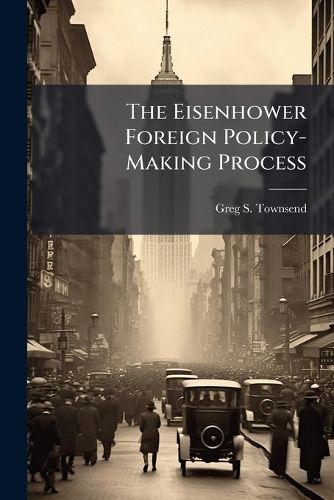Readings Newsletter
Become a Readings Member to make your shopping experience even easier.
Sign in or sign up for free!
You’re not far away from qualifying for FREE standard shipping within Australia
You’ve qualified for FREE standard shipping within Australia
The cart is loading…






President Eisenhower, like all U.S. Presidents, wrestled with the limitations placed on the executive branch of government by the U.S. Constitution; and this structural constant served as an impetus for Eisenhower to seek coordination in his foreign policy via organizational change. This paper will analyze the development of National Security Council (NSC) Policy Paper 162/2, Basic National Security, to determine the impact of Eisenhower's organizational approach to national policy making. Graham Allison's models of governmental behavior, as articulated in his book Essence of Decision, will serve as the framework for analysis. Allison proposed three models of governmental behavior which may be used to explain the Eisenhower administration's foreign policy decision-making process. Governmental behavior as a rational actor, involves the selection of a course of action among alternatives by a unitary decision-maker, after a valuation of costs and benefits. The organizational behavior model attributes governmental decisions to the outputs of standard operating procedures rather than rational analysis. And the governmental politics model explains behavior as the resultant of bargaining, influence, and ultimately power. Eisenhower's reliance on organizational processes, as evidenced by the Policy Planning Board and Operations Coordination Board, support the organizational behavior model.
This work has been selected by scholars as being culturally important, and is part of the knowledge base of civilization as we know it. This work was reproduced from the original artifact, and remains as true to the original work as possible. Therefore, you will see the original copyright references, library stamps (as most of these works have been housed in our most important libraries around the world), and other notations in the work.
This work is in the public domain in the United States of America, and possibly other nations. Within the United States, you may freely copy and distribute this work, as no entity (individual or corporate) has a copyright on the body of the work.
As a reproduction of a historical artifact, this work may contain missing or blurred pages, poor pictures, errant marks, etc. Scholars believe, and we concur, that this work is important enough to be preserved, reproduced, and made generally available to the public. We appreciate your support of the preservation process, and thank you for being an important part of keeping this knowledge alive and relevant.
$9.00 standard shipping within Australia
FREE standard shipping within Australia for orders over $100.00
Express & International shipping calculated at checkout
Stock availability can be subject to change without notice. We recommend calling the shop or contacting our online team to check availability of low stock items. Please see our Shopping Online page for more details.
President Eisenhower, like all U.S. Presidents, wrestled with the limitations placed on the executive branch of government by the U.S. Constitution; and this structural constant served as an impetus for Eisenhower to seek coordination in his foreign policy via organizational change. This paper will analyze the development of National Security Council (NSC) Policy Paper 162/2, Basic National Security, to determine the impact of Eisenhower's organizational approach to national policy making. Graham Allison's models of governmental behavior, as articulated in his book Essence of Decision, will serve as the framework for analysis. Allison proposed three models of governmental behavior which may be used to explain the Eisenhower administration's foreign policy decision-making process. Governmental behavior as a rational actor, involves the selection of a course of action among alternatives by a unitary decision-maker, after a valuation of costs and benefits. The organizational behavior model attributes governmental decisions to the outputs of standard operating procedures rather than rational analysis. And the governmental politics model explains behavior as the resultant of bargaining, influence, and ultimately power. Eisenhower's reliance on organizational processes, as evidenced by the Policy Planning Board and Operations Coordination Board, support the organizational behavior model.
This work has been selected by scholars as being culturally important, and is part of the knowledge base of civilization as we know it. This work was reproduced from the original artifact, and remains as true to the original work as possible. Therefore, you will see the original copyright references, library stamps (as most of these works have been housed in our most important libraries around the world), and other notations in the work.
This work is in the public domain in the United States of America, and possibly other nations. Within the United States, you may freely copy and distribute this work, as no entity (individual or corporate) has a copyright on the body of the work.
As a reproduction of a historical artifact, this work may contain missing or blurred pages, poor pictures, errant marks, etc. Scholars believe, and we concur, that this work is important enough to be preserved, reproduced, and made generally available to the public. We appreciate your support of the preservation process, and thank you for being an important part of keeping this knowledge alive and relevant.